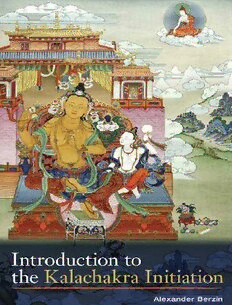
Introduction to the Kalachakra Initiation PDF
Preview Introduction to the Kalachakra Initiation
INTRODUCTION TO THE KALACHAKRA INITIATION INTRODUCTION TO THE KALACHAKRA INITIATION by Alexander Berzin Foreword by His Holiness the Dalai Lama Snow Lion Publications Ithaca, New York Snow Lion Publications P.O. Box 6483 Ithaca, New York 14851 USA 607-273-8519 www.snowlionpub.com Copyright © 1997, 2010 Alexander Berzin All rights reserved. No portion of this work may be reproduced by any means without prior written permission from the publisher. Printed in the USA on acid-free, recycled paper. ISBN 978-1-55939-373-7 The Library of Congress cataloged the previous edition of this work as follows: Berzin, Alexander. Taking the Kalachakra initiation / by Alexander Berzin ; foreword by His Holiness the Dalai Lama. p. cm. Includes bibliographical references. ISBN 1-55939-084-0 1. Kālacakra (Tantric rite) I. Title BQ8921.K34B47 1997 294.3’438--dc21 97-37384 Foreword Throughout the world there is a deeply felt need for both external and internal peace. The Kalachakra initiation is a profound ceremony that gathers and unites people from all nations and backgrounds in a peaceful, spiritual activity that affects both those people and the environment in a significant and constructive manner. For this reason, several lamas, including myself, have been happy to confer the initiation when requested. In preparing this guidebook, Alexander Berzin has done a great service to everyone interested in the Kalachakra initiation. It will help people who receive the initiation from lamas of any of the four lineages of Tibetan Buddhism to prepare for the ceremony and understand the essential points of each step of the procedure. By explaining clearly the Kalachakra path of spiritual development, as well as the vows and commitments involved, the book will help people to make a realistic decision about whether to take the empowerment as a full participant or merely as an observer. Many people who are not yet ready to engage in Kalachakra meditation practice, and many who are not even Buddhists but have sincere wishes for peace, attend the initiation as interested observers. I am especially happy that the book addresses this section of the audience as well, suggesting ways in which they can make the experience more meaningful. It is my prayer that everyone who plans to attend, or has ever attended a Kalachakra initiation may ultimately reap the full benefit of doing so. April 8, 1997 Preface For several decades, masters from all four lineages of Tibetan Buddhism have been conferring the Kalachakra initiation in India, Mongolia, Southeast Asia and the West. Thousands of people from Buddhist and non-Buddhist cultures alike have either received the empowerment as active participants or attended as interested observers. Requests for future Kalachakra initiations from around the world are ever-increasing. The interest is great. Only a handful of Westerners attended the first Kalachakra empowerment His Holiness the Dalai Lama conferred outside Tibet, and I had the good fortune to be among them. This was in Dharamsala, India, in March 1970. Seeing that many more Westerners would come to future initiations, His Holiness decided to make available some guidelines and background information about Kalachakra for this new audience. Thus several months before the Kalachakra empowerment he next conferred in Bodh Gaya, India, in December 1974, His Holiness commissioned Sharpa Rinpochey and myself to translate a series of articles on Kalachakra written by Geshey Ngawang Dhargyey and Garjang Kamtrul Rinpochey. The Library of Tibetan Works & Archives published them in Dharamsala, and Deer Park reprinted the one by Geshey Dhargyey as part of the manual they prepared for His Holiness’s first conferral of the initiation in the West. This was in Madison, Wisconsin, in July 1981. Organizers of later Kalachakra initiations have frequently reprinted this manual both in English and several European languages. His Holiness also commissioned Professor Jeffrey Hopkins to translate and publish the text of the initiation ritual so that participants could follow more easily. His Holiness’s main Kalachakra teacher was Tsenzhab Serkong Rinpochey, his late master debate partner and assistant tutor. Serkong Rinpochey was the son and spiritual heir of Serkong Dorjeychang, an outstanding master of Kalachakra and a member of its lineage. Serkong Rinpochey was also my own root guru, whom I served for many years as interpreter. Seeing that there would be ever-growing interest in the West about Kalachakra, he taught me the subject extensively. This included not only formal teaching on its many commentaries, but informal explanations on Kalachakra equivalents to almost anything I translated for him. He never tired of discussing the topic and did so at home, on the road and even at the dinner table, both in India and everywhere we traveled on his lecture tours of the West. He particularly delighted in the details of the three-
